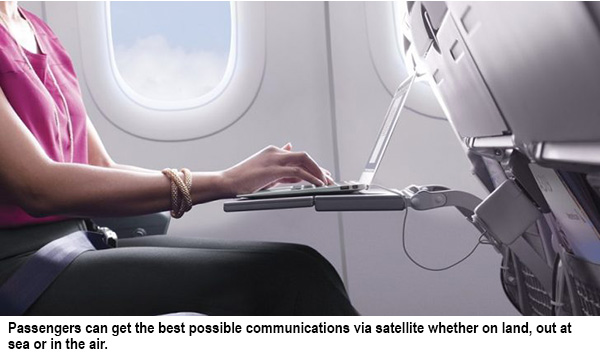Mobility for the Masses
by Andrew Faiola
 Communications are undergoing a complete transition from what we know as the norm, towards a somewhat unknown reality, where anything and everything will eventually be connected. Of course, this is no easy feat for established networks built on fixed, tried and tested infrastructure and as new applications such as the Internet of Things (IoT), continues to advance and connected objects become commonplace, universal high-capacity, high-speed connectivity will become a necessity, anywhere and everywhere. Consequently, the role of satellite will play a growing role, delivering seamless, high-bandwidth broadband services to once unimaginable locations, including out at sea and in the sky.
Communications are undergoing a complete transition from what we know as the norm, towards a somewhat unknown reality, where anything and everything will eventually be connected. Of course, this is no easy feat for established networks built on fixed, tried and tested infrastructure and as new applications such as the Internet of Things (IoT), continues to advance and connected objects become commonplace, universal high-capacity, high-speed connectivity will become a necessity, anywhere and everywhere. Consequently, the role of satellite will play a growing role, delivering seamless, high-bandwidth broadband services to once unimaginable locations, including out at sea and in the sky.
Digital Transformation
When it comes to the ways in which consumers demand data, their usage is now not only confined to a physical location. The huge draw to Over-the-top Services (OTT), has led to people demanding data for streaming, whenever and wherever they are. For example, more people in India than ever are consuming content on their phones as their primary means of viewing. This is just one example of how expectations for ‘always on’ connectivity has increased in recent years. This shift in expectations has also taken the hunger for services to new realms in the form of the rise in demand for Communications on the Move (COTM) services. As whole populations shift consumption habits, a strategic infrastructure of the right kind of connection and the most suitable equipment to carry the service is now required.
Satellite Evolution
In the past, VSAT networks were small and they were used solely to provide broadband connectivity to predominantly rural areas that were beyond the reach of traditional infrastructures. This has now changed and there has been a sizable shift in where satellite can deliver, due to the strategic and increased use of teleports to open up new services in new locations around the world.
Today’s satellites are not only able to deliver connectivity but in fact revolutionise what was once possible, bringing significant new capabilities at the same time. One of the factors that has made this all possible is the different types of equipment now being deployed are of immense capabilities. From the smaller satellite footprints of the past, made of a limited number of beams and terminals, to the networks of today, where a much larger area is covered, using thousands of terminals with hundreds of beams. This, combined with the powers of High Throughput Satellite (HTS), creates a winning combination able to transform and shape those communications, positioning satellite as the key player in the field of COTM.
When it comes to COTM, satellite communications are ideally positioned to achieve the best possible results for users – whether on land, out at sea or in the air. This is as true for an individual passenger on a cruise as it is for a military aeroplane seeking the best position to land in a warzone, using on-board communications as part of its navigation system. For the latter, it is not only a robust connection that is needed, but a completely secure, reliable one that can be relied upon at any critical moment, regardless of the path of the aircraft. For offshore and maritime markets, increased demand for higher data throughputs that can support bandwidth intensive services in those remote locations is rising at an unprecedented rate. The kinds of services that are now required include video conferencing, and media streaming – another example of the rapid spread of desire for OTT services, even out at sea.
In terms of COTM, land communications in these areas are crucial and satellite technologies are being deployed to this more and more, connecting vehicles reliably as they pass through any terrain either through a direct connection or by enabling cost-effective extension of the terrestrial network to remote areas that could not be connected otherwise.
Airborne Efficiencies
 COTM spans several formats, on land, over sea and in the air, with applications including In-Flight Connectivity (IFC), connected vehicles and government operations in areas ranging from humanitarian aid missions to the powering of on-board IoT applications in rescue operations. Each application requires a unique and variable set of characteristics, such as the amount of bandwidth required, security, and selecting the right ground technology.
COTM spans several formats, on land, over sea and in the air, with applications including In-Flight Connectivity (IFC), connected vehicles and government operations in areas ranging from humanitarian aid missions to the powering of on-board IoT applications in rescue operations. Each application requires a unique and variable set of characteristics, such as the amount of bandwidth required, security, and selecting the right ground technology.
IFC, for example, is a huge area of interest and an area that will continue to grow substantially in the near future. For IFC to be successfully delivered, there are certain aspects that need to be carefully considered and specific requirements that need to be finely tuned. Panasonic Avionics is pioneering the journey towards seamless IFC in response to the increasing demand we are seeing. It has carried out a major upgrade of its satellite network to increase the data rates available to airplanes by at least 20 times. The new network also leverages the latest transmission standard DVB-S2X, unleashing the full power of HTS.
At the core of the upgrade is a new satellite modem which we developed in conjunction with Panasonic Avionics as part of the Newtec Dialog® VSAT platform. This modem dramatically improves data rates to unlock services such as faster Internet, Voice-over-IP (VoIP) applications, improved TV picture quality and a broader channel choice, 3G phone services, and additional bandwidth for crew applications. It is also extremely scalable and will continue to meet the evolving needs of airlines and their passengers for many years to come.
As well as fully supporting wideband DVB-S2X, the modem is also equipped with Newtec’s latest Mx-DMA® return technology. This combines the efficiency of SCPC with the dynamic bandwidth allocation capabilities of TDMA to deliver up to 300 percent more data than legacy TDMA systems.
To reduce the interruption that occurs during satellite transitions, the modem also supports advanced beam switching capabilities, enabled by dual onboard receivers. This allows two separate satellite beams to be tracked, reducing beam switch times. A third receiver enables simultaneous reception of our live TV content and recently-launched “ZeroTouch” service, which aims to disrupt long media update cycles and simplify data transfer of passenger-facing content.
Moving with the Times
These advancements in the air are matched by technology evolution at sea. As the maritime industry sees rising connectivity demands, solutions with very high data rates, both forward and return, and increased efficiency are vital. Milano Teleport, for example, saw this rise in demand first-hand. It opted for the Newtec Dialog multi-service platform, combined with two modems, to meet this demand and unlock the power of HTS. The solution included sophisticated mobility functionality including unique flexibility to manage beam switching in a global network, minimizing service downtime.
Companies such as Panasonic and Milano Teleport not only show the potential satellite has to deliver on the goal of ubiquitous connectivity but also how it is already fulfilling this requirement, satisfying rising customer demands in places where connectivity was not previously given a second thought.
As COTM advances further and demands increase, new possibilities for not only consumers to tap into new services will emerge, but also lucrative ways for operators to monetise services will be revealed. Although some markets are only scratching the surface of what’s possible, it is only a matter of time before these new horizons become the norm and there really will be no boundaries to be crossed in terms of keeping people, and things connected on the move, however they travel.
----------------------------------------------
 Andrew Faiola is currently Head of Mobility at Newtec, where he is responsible for the company’s strategy for aviation, maritime, and land mobile. Previously, Andrew spent 15 years at Intelsat, the world’s leading satellite company, in a number of different direct account management and leadership positions, most recently leading the Mobility Solutions sales team for Europe, Middle East, and Asia. He also held various sales and marketing roles at NewSkies Satellites, and at an independent teleport in the USA called ESATEL Communications. Earlier in his career he performed research and project development work at the Center for Strategic & International Studies (CSIS), the Embassy of Mexico in Washington, DC, and at NASA, which involved the provision of Internet service and remote sensing for environmental purposes. He can be reached at: afai@newtec.eu
Andrew Faiola is currently Head of Mobility at Newtec, where he is responsible for the company’s strategy for aviation, maritime, and land mobile. Previously, Andrew spent 15 years at Intelsat, the world’s leading satellite company, in a number of different direct account management and leadership positions, most recently leading the Mobility Solutions sales team for Europe, Middle East, and Asia. He also held various sales and marketing roles at NewSkies Satellites, and at an independent teleport in the USA called ESATEL Communications. Earlier in his career he performed research and project development work at the Center for Strategic & International Studies (CSIS), the Embassy of Mexico in Washington, DC, and at NASA, which involved the provision of Internet service and remote sensing for environmental purposes. He can be reached at: afai@newtec.eu





